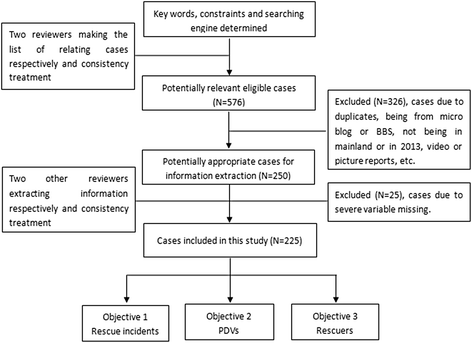Mortality among drowning rescuers in China, 2013: a review of 225 rescue incidents from the press
- PMID: 26156246
- PMCID: PMC4496822
- DOI: 10.1186/s12889-015-2010-0
Mortality among drowning rescuers in China, 2013: a review of 225 rescue incidents from the press
Abstract
Background: Drowning is common worldwide. Rescue efforts attempted by untrained bystanders often lead to the death of the primary drowning victim (PDV), the rescuer or both. Our study aimed to inform prevention by identifying risk factors in rescuer drowning.
Methods: Data on drowning rescue incidents reported online in mainland China, 2013, were reviewed. Information on the drowning incidents, PDVs and rescuers were retrieved for analysis.
Results: A total of 225 rescue incidents were identified, of which 14 were victim-rescuer drowning incidents (VRDIs) (6.2%). A person-to-person rescue by swimming to PDVs was the most commonly used method (58.9%). Resuscitation was given immediately to 35.5% of PDVs after rescue. The mortality rate of the rescuers (13.3%) was similar to that of the PDVs (11.5%) (χ(2) = 0.5, p =0.49). Being an adult (OR = 0.2, 95% CI: 0.1-0.5) and other than the first rescuer (OR = 0.4, 95% CI: 0.2-0.9) decreased the risk of rescuers drowning.
Conclusions: Most of the currently employed life-saving methods are dangerous and even potentially life threatening. The idea of "rescuers' safety first" should be embraced, especially with teenage and child rescuers, who should never be encouraged to rescue others without first guaranteeing their own safety. Promotion of basic rescue skills should be implemented in the general public.
Figures
Similar articles
-
Descriptive Epidemiology of Rescue-Related Fatal Drowning in Turkey.Int J Environ Res Public Health. 2021 Jun 19;18(12):6613. doi: 10.3390/ijerph18126613. Int J Environ Res Public Health. 2021. PMID: 34205391 Free PMC article.
-
A study on rescuer drowning and multiple drowning incidents.J Safety Res. 2012 Apr;43(2):129-32. doi: 10.1016/j.jsr.2012.05.001. Epub 2012 May 18. J Safety Res. 2012. PMID: 22709998
-
A study on multiple drowning syndromes.Int J Inj Contr Saf Promot. 2012;19(1):63-7. doi: 10.1080/17457300.2011.603154. Epub 2011 Aug 9. Int J Inj Contr Saf Promot. 2012. PMID: 21827292
-
Lay-rescuers in drowning incidents: A scoping review.Am J Emerg Med. 2021 Jun;44:38-44. doi: 10.1016/j.ajem.2021.01.069. Epub 2021 Jan 31. Am J Emerg Med. 2021. PMID: 33578330
-
Studying outcome predictors of drowning at the scene: Why do we have so few answers?Am J Emerg Med. 2021 Aug;46:361-366. doi: 10.1016/j.ajem.2020.10.011. Epub 2020 Oct 10. Am J Emerg Med. 2021. PMID: 33069542 Review.
Cited by
-
Assessing variations in estimates of drowning mortality in Turkey from 2013 to 2019.Arch Public Health. 2022 Aug 1;80(1):178. doi: 10.1186/s13690-022-00944-w. Arch Public Health. 2022. PMID: 35915470 Free PMC article.
-
Descriptive Epidemiology of Rescue-Related Fatal Drowning in Turkey.Int J Environ Res Public Health. 2021 Jun 19;18(12):6613. doi: 10.3390/ijerph18126613. Int J Environ Res Public Health. 2021. PMID: 34205391 Free PMC article.
-
The potential use of social media and other internet-related data and communications for child maltreatment surveillance and epidemiological research: Scoping review and recommendations.Child Abuse Negl. 2018 Nov;85:187-201. doi: 10.1016/j.chiabu.2018.01.014. Epub 2018 Feb 1. Child Abuse Negl. 2018. PMID: 29366596 Free PMC article.
-
The Combined Effects of Short-Term Exposure to Multiple Meteorological Factors on Unintentional Drowning Mortality: Large Case-Crossover Study.JMIR Public Health Surveill. 2023 Jul 20;9:e46792. doi: 10.2196/46792. JMIR Public Health Surveill. 2023. PMID: 37471118 Free PMC article.
-
Characteristics of aquatic rescues undertaken by bystanders in Australia.PLoS One. 2019 Feb 14;14(2):e0212349. doi: 10.1371/journal.pone.0212349. eCollection 2019. PLoS One. 2019. PMID: 30763388 Free PMC article.
References
-
- Schilling UM, Bortolin M. Drowning. Minerva Anestesiol. 2012;78(1):69–77. - PubMed
-
- Soar J, Perkins GD, Abbas G, Alfonzo A, Barelli A, Bierens JJ, et al. European Resuscitation Council Guidelines for Resuscitation 2010 Section 8. Cardiac arrest in special circumstances: Electrolyte abnormalities, poisoning, drowning, accidental hypothermia, hyperthermia, asthma, anaphylaxis, cardiac surgery, trauma, pregnancy, electrocution. Resuscitation. 2010;81(10):1400–33. doi: 10.1016/j.resuscitation.2010.08.015. - DOI - PubMed
MeSH terms
LinkOut - more resources
Full Text Sources
Other Literature Sources
Medical


